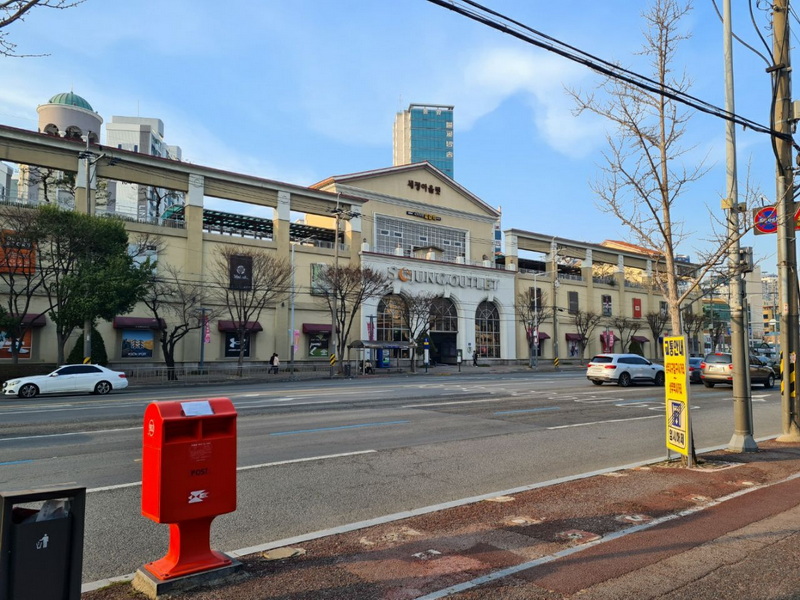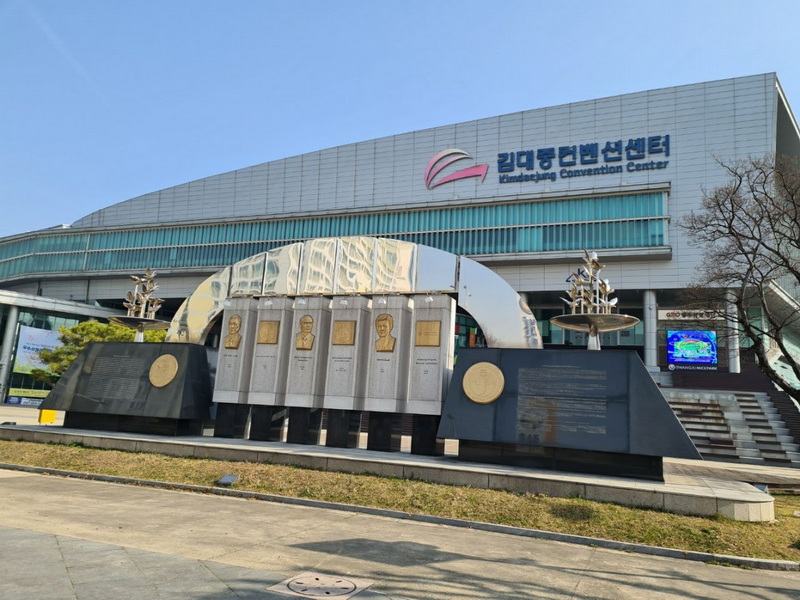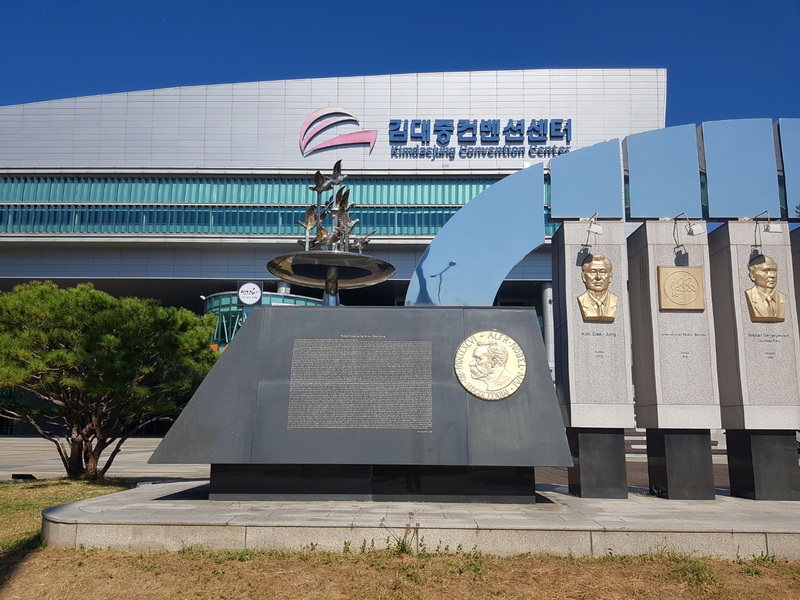Exploring the Sangmu District: Gwangju’s Hub of Food, Finance, Governance, and More
By Umesh Mansukhani
Kim Dae Jung Convention Center, which opened on September 6, 2005, is on an international scale, a state-of-the-art exhibition convention center with 40,046 square meters of exhibition floor area, a total of 29 conference rooms, and a 3,000-seat-capacity multi-purpose hall. On the first floor there is a “Kim Dae Jung Hall” in honor of the late President. It consists of books, photos, gifts, souvenirs, pledges, certificates, and writings to honor the achievements of former President Kim Dae-jung, who devoted his life to the promotion of democratization, world peace, and human rights.
Gwangju Metropolitan City Hall is also in the Sangmu District and has a large area of 94,000 square meters, most of which is used as an outdoor plaza. There is a lawn plaza, an outdoor music hall, and a rose garden where various performances and events are held. Every summer, the grass plaza is opened to be used as a camping ground, and every winter an outdoor skating rink can be enjoyed by the people.

Sangmu Station is an underground station of Gwangju Metro Line 1. After exiting from this station, one can visit the following tourist destinations: Uncheon Reservoir, Sejong Outlet, Lotte Mart, Mugaksa Temple, City Hall, Arts Center, Chipyeong-dong, Peace Park, and Kyobo Bookstore. The commercial area around Sangmu Station consists of restaurants, coffee shops, bakeries, convenience stores, hotels, banks, night clubs, and pubs.
Sangmu Citizens’ Park has got a large square where, every Friday, a traditional market is opened by the farmers who sell their products such as vegetables, fruits, fresh fish, Korean side dishes, and fresh meat directly to the people at reasonable prices. There are also ready-made varieties of delicious foods, and it is fun to look around after one has worked hard during the week.
Sejong Outlet, located above the Sangmu Station, is a large shopping paradise where one can buy famous high-end local and foreign brands at prices 25–75 percent cheaper than usual (excluding some items) 365 days a year. Good products from 130 famous brands with proven reliability and product quality can be found in the stores here. Sports clothing, women’s wear, men’s wear, outdoor clothing, golf wear, casual wear, baby/children’s clothes, lingerie, shoes, bags, and accessories can be purchased here. Brands such as Crocs, Prospecs, FILA, Renoma, Spider, Mizuno, Kolon Sports, Under Armour, Nike, Adidas, Papageno, Valencia, Olivia Lauren, Calvin Klein, Mako, TBJ, Missha, ABC Mart, Puma, and Dynafit can all be found here.
Sangmu District has got a variety of famous restaurants offering delicious food, too. So, check out the restaurants to satisfy your hunger. Numerous notable restaurants (and their cuisines) are on offer here, including Mudeung Wang Katsu (king pork cutlet), Shinjukkumi (octopus cuisine), Sangchu Ttwigim (tempura wrapped in lettuce), Sanil Neungi (mushroom chicken soup), Wondumak (raw beef), Yukjeon Hanok (yellow croaker), Gungjeon Kimchi Jjigae (pork-kimchi stew), Daesoyang (grilled pork giblets), and Chang Baeksan (lamb skewers). You will find yourself coming back to these restaurants over and over again.

Sangmu District has the largest number of traditional bakeries in Gwangju. The Mareuk Bakery smells like butter and is famous for bread and scones. You must visit and try a few other reputed bakeries such as Dasbrot (vegan), Lala Bakery, Neulis Neulis Gwajajeom, and The Geonganghan Ppang for their delicious roll cakes, sandwiches, and birthday cakes.
Coffee was introduced in Korea during the Joseon era. During the reign of King Gojong (r. 1863–1907), the twenty-sixth Joseon monarch, coffee was served to the king and other high-ranking officials and diplomats in the palace. In Sangmu, the traditional coffee shops are Cockle (for espresso and con panna), Slyfox (with its Sherlock concept interior), Espresso Sumuk, Sixbox, and Tea Room Jade.
Sangmu is also a financial district where all the major banks and investment firms are located. For your banking needs, one can visit Hana Bank, Kookmin Bank, Woori Bank, NongHyup Bank, and Shinhan Bank. For one’s investment requirements, approach the stock analysts at Samsung Securities, Mirae Asset, NH Investment, KB Securities, and SK Securities.
If you plan to stay a while, Sangmu District has got the best lodging and boarding facilities. There is a large variety of branded and boutique hotels here, serving lavish buffets for breakfast, brunch, lunch, and dinner. To name a few, visit the Ramada Plaza, Holiday Inn, D’yoo Hotel, Hotel Stay 53, and UTOP boutique hotel.
In order to secure medical insurance coverage, do visit the office of the National Health Insurance Service in Sangmu. Nearby there is Aladdin, the largest second-hand store selling English books and magazines at very low prices. To get to all the aforementioned places, nearby subway stations are Uncheon Station and Kim Daejung Convention Center Station.
While I was enjoying the sights and smells of Sangmu, I found many youngsters in their teens around me. As I kept asking for directions to find my way around, many offered to help. I was surprised to see that nowadays, a majority of the young boys and girls can communicate in English. I would like to mention one lovely lady, Miss Shin Hyun-soo, who took me around showing me the sights of the vibrant Sangmu District.
To conclude our exploration of Sangmu, I will end with two inspiring travel quotes:
“Live your life by a compass, not a clock.” – Stephen Covey
“Travel is never a matter of money, but of courage.” – Anonymous.
The Author
Umesh Mansukhani is from India and is a freelance English tutor. He loves traveling, playing ping-pong and chess, and watching Korean dramas.







